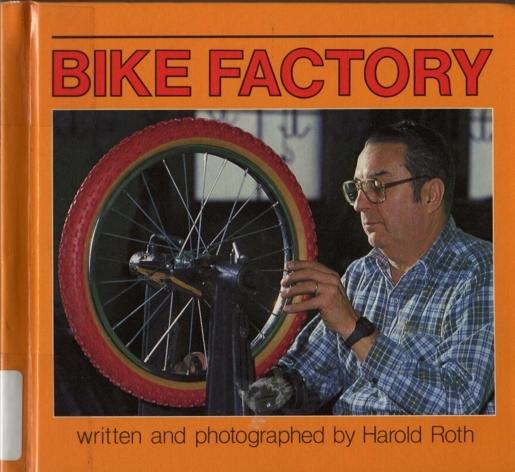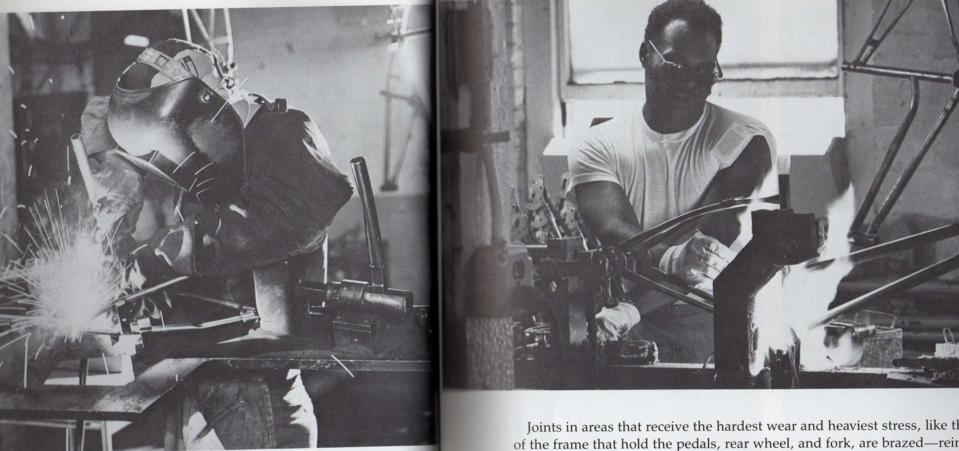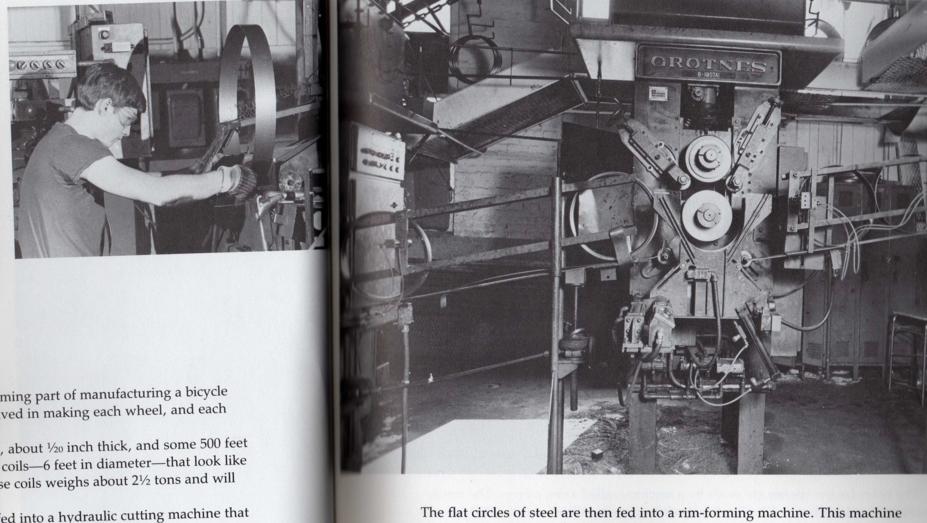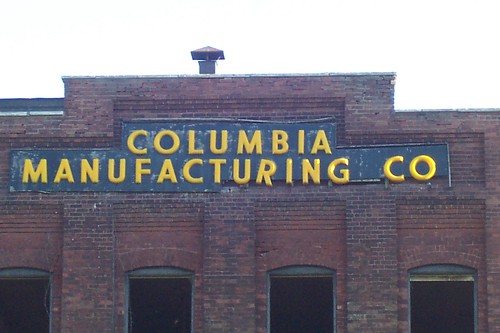“Bike Factory” photobook by Harold Roth.
March 10th, 2009
 I got this book from the library and it’s pretty fun. Its full of photographs from the Columbia Manufacturing plant in Westfield MA, which opened in 1897 . Since the book’s publication of course Columbia has gone bankrupt (1987) and bike are no longer made there. I guess this is technically a kids’ book, 35 pages, but whatever.
I got this book from the library and it’s pretty fun. Its full of photographs from the Columbia Manufacturing plant in Westfield MA, which opened in 1897 . Since the book’s publication of course Columbia has gone bankrupt (1987) and bike are no longer made there. I guess this is technically a kids’ book, 35 pages, but whatever.
Here are a couple of page scans I like. Steel tube being brazed and welded by hand:
Steel tubes were also bent into handlebars by a hand-operated machine (not show here). Steel being cut and stamped (by some crazy-ass industrial machine) into rims:

 I also found a video. I hope the good people that got laid off from Columbia have done well since then. I also wonder whether the Westfield factory would be a killer abandoned building to
I also found a video. I hope the good people that got laid off from Columbia have done well since then. I also wonder whether the Westfield factory would be a killer abandoned building to break into explore, and if any of the machines and parts are still there, collecting dust.
As for the next chapter of American bicycling history (I joke), I’ve dropped off my resume to every shop in the area that I could imagine working at. Just waiting for callbacks now. The economy sucks so who knows. Bike mechanics school is going really well, I’m learning a ton of things that aren’t in any of repair books I’ve read … two thumbs up. Here’s a g-chat excerpt I just had with my cousin, who lives on the west coast:
me: i may move to sf soon
him: that’s a big step, you think this city wants you out here?
they already have enough punk ass bike riders
me: if i dont get a job by april. i can’t sit around here at home forever
him: where would you stay if you came up?
me: with you for like a week. then i would sublet for a couple months and play it by ear
him: haha, who is ‘you’?
is that your asian friend?
me: whatever.
Well that’s about as much moral support as I get from my parents these days too, so I’ll take it.
bike repair book review – The Chainbreaker Bike Book
February 8th, 2009
Recently I’ve been reading pretty much every book on bike mechanics I can get a hold of. One thing I really like to do, especially if I’m traveling, is to walk into the central public library and make my way towards call number 629.227. Most bike books get shelved there, and sometimes under R(eference)629.227. I’ve found some really interesting reads this way, and I want to start remarking briefly on the one’s I’ve like the most. I’m going to start with Shelley Lynn Jackson & Ethan Clark’s The Chainbreaker bike book because it stands out from everything else I’ve read.

I liked this book for its style and perspective. It’s written by two mechanics/volunteers from New Orleans and resembles a DYI zine more than a dry, professional repair book. Actually, Shelly had started a bike zine called Chainbreaker, but the project was canceled after ‘Cane Katrina. All four issues of the zine are reproduced in the second half of this book.
I appreciated Shelly’s perspective as a female mechanic. She goes on for a little while describing all the BS she has to deal with at the shop and I think that after taking it all in it will help me stay aware and sensitive of how women are treated in shops and the bike scene. I also appreciated Ethan’s account of going from working at an unpretentious LBS to a high-end chain store. He basically said it sucked working on nice bikes for rich people all day, because he didn’t feel like he was doing as much good for people as he had when he fixed bikes for people who depended on them on a daily basis. That resonated with me because I’m more interested in commuter riding than racing or doing anything competitive on a bike. At one point in the boo, it might have been the zine reprint section, there were some words regarding fixies, and it went something like (paraphrasing) …. “whoa, can everyone just chill out and stop being so obsessed with components and competing for the nicest ride? let’s just encourage people to ride bikes and stop being so pretentious and intimidating.”The city of New Orleans definitely looms large over the writing of this book. Both authors were volunteers at Plan B, a community bike organization, and I just got a really good impression of both N.O and Plan B, enough to spark an interest in visiting N.O. soon.
As for mechanical advise in this book –by the time I got around to Chainbreaker, I’d already read a lot of cut and dry repair books, so I wasn’t really scrutinizing this part of the book too much. Really it’s likely not the best first/only book on repair to read, since the illustrations are sketched in black and white. It did however give a good explanation of why freehubs and better than freewheels.
In all I liked this book and you should check it out, unfortunately no library in New England has it on their shelves. Ask you local branch to order it? They are required to spend like 20% of their budget on new books, you know…. Or order it from the publisher for 12 bucks here.
